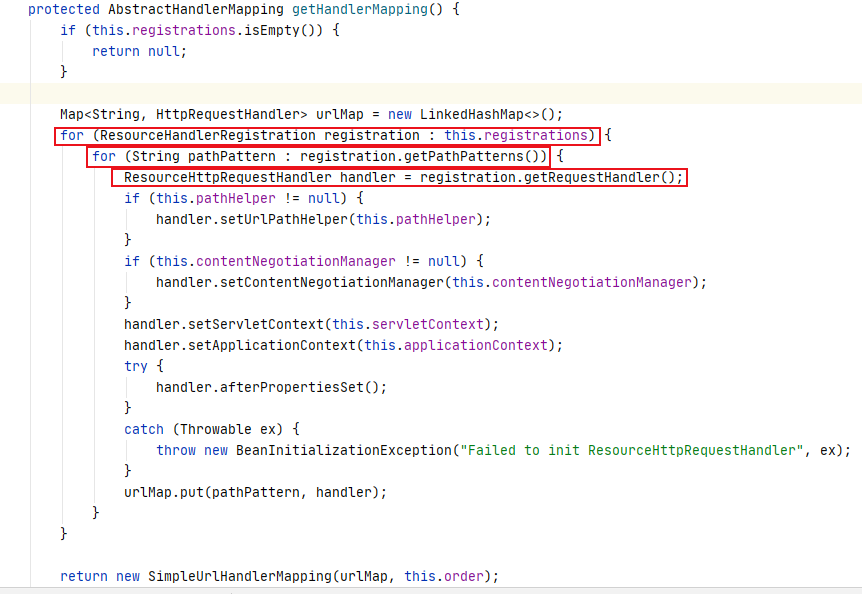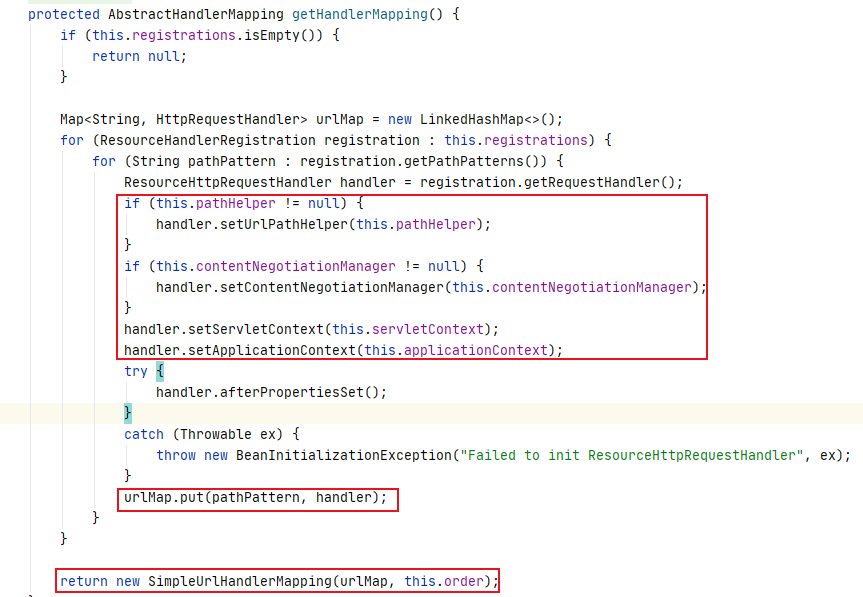源码探究
原文链接:https://blog.csdn.net/cristianoxm/article/details/112639177
这篇博文全篇都在讲WebMvcAutoConfiguration类中addResourceHandlers;讲的很精彩;
静态资源探究就是在看addResourceHandlers中的源码:
@Override
public void addResourceHandlers(ResourceHandlerRegistry registry) {
if (!this.resourceProperties.isAddMappings()) {
logger.debug("Default resource handling disabled");
return;
}
Duration cachePeriod = this.resourceProperties.getCache().getPeriod();
CacheControl cacheControl = this.resourceProperties.getCache().getCachecontrol().toHttpCacheControl();
if (!registry.hasMappingForPattern("/webjars/**")) {
customizeResourceHandlerRegistration(registry.addResourceHandler("/webjars/**")
.addResourceLocations("classpath:/META-INF/resources/webjars/")
.setCachePeriod(getSeconds(cachePeriod)).setCacheControl(cacheControl));
}
String staticPathPattern = this.mvcProperties.getStaticPathPattern();
if (!registry.hasMappingForPattern(staticPathPattern)) {customizeResourceHandlerRegistration(
//这里会创建一个ResourceHandlerRegistration对象
registry.addResourceHandler(staticPathPattern)
//这里采用了链式编程,是同一个ResourceHandlerRegistration对象;
.addResourceLocations(getResourceLocations(this.resourceProperties.getStaticLocations()))
.setCachePeriod(getSeconds(cachePeriod)).setCacheControl(cacheControl));
}
}
对于这篇博客中稍有疑问的是这两句:
# 这一句是指:它从resourceProperties属性类中获取到关于缓存的相关值。//我们可以在ymml配置文件中配置一下这个值;
Duration cachePeriod = this.resourceProperties.getCache().getPeriod();
# CacheControl类是http报文中的通用首部字段,既存在于请求报文中,也存在于响应报文中;//这个不可以在yml中配置,不用管;
CacheControl cacheControl = this.resourceProperties.getCache().getCachecontrol().toHttpCacheControl();.
关于CacheControl博文: https://blog.csdn.net/zhongshanxian/article/details/81289034
在源码探究中,参与的比较多的有两个类:ResourceHandlerRegistry/ResourceHandlerRegistration
原文链接:https://blog.csdn.net/andy_zhang2007/article/details/89133798
一个ResourceHandlerRegistry中存储着一个List
一个ResourceHandlerRegistration中存储着:
private final String[] pathPatterns; //路径模型
private final List<String> locationValues = new ArrayList(); //路径模型对应的:静态资源的路径地址;
在springboot中如何生成一个HandlerMapping的
原文链接:https://blog.csdn.net/andy_zhang2007/article/details/99545776
WebMvcConfigurationSupport类中的 resourceHandlerMapping(....);
ResourceHandlerRegistry类中的 getHandlerMapping();//方法详解
//这里新建了并返回了一个ResourceHttpRequestHandler
ResourceHandlerRegistration类中的 getRequestHandler();
1.通过WebMvcConfigurationSupport类中的 resourceHandlerMapping(....);我们可以了解,如何完整的返回一个静态资源映射处理器==

2.我们可以看到在resourceHandlerMapping(....)方法中,调用了registry.getHandlerMapping()方法;

在getHandlerMapping()方法中,先是将ResourceHandlerRegistration迭代出来;此时ResourceHandlerRegistration中的pathPatterns与
locationValues是N:M的关系;再将pathPatterns遍历,然后调用registration.getRequestHandler()方法;

在getRequestHandler()方法中,创建了一个ResourceHttpRequestHandler对象,并将当前ResourceHandlerRegistration对象中的locationValues,cacheControl,cachePeriod等属性全部配置到到ResourceHttpRequestHandler中,并返回ResourceHandlerRegistration对象;
然后在往下看,将ResourceHandlerRegistry对象中的属性全部配置到ResourceHttpRequestHandler对象中,再用一个key为pathPattern,value为ResourceHttpRequestHandler的map将他们以1:n的关系联系在一起。再将该map由一个SimpleUrlHandlerMapping对象包裹起来返回到resourceHandlerMapping中;

然后再为SimpleUrlHandlerMapping配置一些信息。到此全部结束。

总结:
1.在WebMvcAutoConfiguration类中addResourceHandlers(...)中配置好pathPatterns与locationValues之间的对应关系;
2.在WebMvcConfigurationSupport类中resourceHandlerMapping(...)中
根据ResourceHandlerRegistry与ResourceHandlerRegistration返回一个HandlerMapping;
3.HandlerMapping中包含了一个Map;这个Map中包含了pathPattern与ResourceHttpRequestHandler;对应关系为1:1;
ResourceHttpRequestHandler对象中配置了locationValues;这样就导致了pathPattern与locationValues的对应关系为1:M;
因为locationValues是一个List<String>类型;